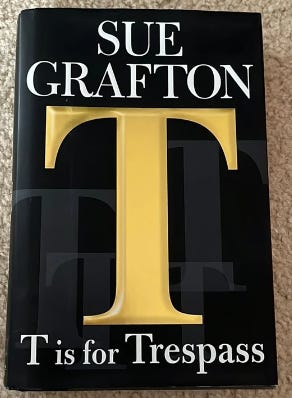For the most part,I am still enjoying my journey through the Sue Grafton Alphabet Books, the A to Y adventures of Kinsey Millhone, the tough on the outside, tender to those she loves ex-cop turned P.I. who plied her trade in 1980’s Santa Teresa, California.
This week it’s T is for Trespass, in which Kinsey is not working a big case, but involves herself informally in a situation faced by her cantankerous neighbour Gus Vranksy. The villain in the piece is a live-in nurse who’s been engaged to care for him, and seems to have ulterior motives. That plotline affords Grafton a great opportunity to explore the vulnerability of seniors, the callousness of some family members with regard to their care, and the wisdom of carefully vetting those who we hire for personal care duties.
I do enjoy it when a mystery novel makes me think about more than the crime.
There is a sub-plot I am enjoying less, involving Kinsey’s part-time gig as a process server. She’s been hired by a developer who’s purchased some rental properties, and is employing rent hikes as a tactic to force out tenants he deems undesirable.
Kinsey seems, at least at this point in the novel (about half way) to accept the developer’s plan as within his rights as a property owner, and raises no moral qualms, even in her internal dialogue. That’s not terribly surprising, since he’s the one paying her.
What was surprising is Grafton has her protagonist, whose back story includes being orphaned at the age of five and growing up in a trailer park, voice what I hear as highly biased comments about people who are just one step from being homeless.
“Deadbeats tend to be centrally located. Certain neighbourhoods and certain enclaves, being rundown and cheap, apparently attract like-minded individuals. Perhaps some people, even those in the crudest circumstances, were still living beyond their means and therefore got sued, served, and summoned to court by those to whom they were indebted. I could imagine a population of the fiscally irresponsible exchanging tricks of the trade: promises, partial payments, talk of checks in the mail, bank errors, and lost envelopes. These were the people who imagined they were somehow exempt from accountability. Most matters that passed through my hand spoke of those who felt entitled to swindle and deceive. They cheated their employers, stiffed their landlords, and blew off their bills. Why not? Going after them too time and money and netted their creditors little. People without assets are bulletproof. You can threaten all you like, but there’s nothing to collect.”
I’ve chatted with owners of rental properties who’ve had enough bad experiences with long-term tenants that they’ve shifted into the vacation rental business, accepting only short-term renters, at higher rates to offset their risks. If I’d invested in an income property I’d want the business to work, and not be hampered by the issues Kinsey describes.
Even so, Kinsey makes pronouncements about whole neighbourhoods and all who inhabit them. She does so uncritically, without pause to consider that the people she meets in her work as a process server by definition fall into a particular segment of the population, those who are in arrears. The assumption that “all those people” are the same seems out of character.
Or maybe I just don’t like it.
There is a reminder here for me, as I put thoughts in the mind of my protagonist, to consider how my own biases seep in to his brain.
All of this rumination has left little room to talk about the preceding adventure, S is for Silence. That was a bit of strange one, that left me wondering about technique.
When an author uses multiple points of view that are all in the same time period, I don’t question it. The view and ear over the shoulders of the villain, and other possible suspects, can be a great way to let the reader know more than the protagonist. But, in S is for Silence the crime Kinsey investigated was a decades old murder.
I found it a bit off-putting that Grafton gave us long scenes from the past, that were not prologue, but simply a showing of events as they occurred, long before Kinsey’s efforts to unearth the truth.
Perhaps it’s a lack of authorial confidence, but I don’t think I’d try that. It felt a bit like cheating somehow.
In my novel The Book of Answers I used the device of a long-forgotten journal, to offer my investigator a window into the past. Even then, I felt the need to hide (in plain sight) the details he and the reader would need to make a deduction.
This is likely less a matter of right or wrong ways to tell the story, and more about what I feel like I could pull off.






Mid - S is where I stopped. I had enjoyed most of the earlier ones so long.